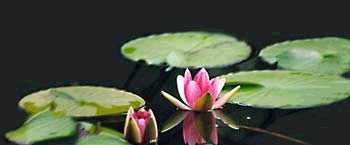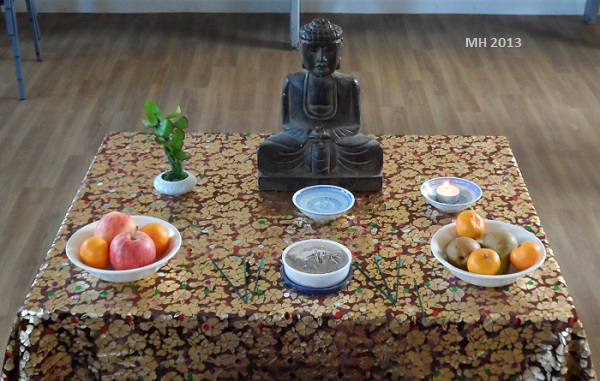

Introducing Buddhism course,
tutor: Mike Horne
The Buddhist altar

Buddhists do not worship the Buddha. But they often have an altar with statues or images. And they often make offerings at the altar. The statues and images are used as a reminder of the need to follow the Buddhist path and the offerings are symbolic of the wish to give up wealth and selfish actions for the sake of others. Buddhists do not pray to the Buddha, but they may offer up prayers for the benefit of others or wish to "transfer merit" (deliberately try to give away the benefits of their practice to others, particularly to friends and relatives who are ill or going through a rough time)
Here are some objects that you may find on a Buddhist altar:
A Buddha Rupa - a statue of a Buddha, often the historical Buddha - Shayamuni. The Buddha represents the historical Buddha who passed on his teaching; the Buddha-Nature within; every ones' potential to become enlightenment; the individual's aspirations to become enlightened. The statue is usually raised up above the other objects, perhaps on a box containing family relics or gifts from friends. A picture may be used in place of a statue; and a large picture or poster may be hung behind he altar.
Flowers - representing the impermanence of all living things: they are beautiful now but will die. Some Buddhists prefer to use a living plant or artificial flowers so they do not damage a plant by cutting the flowers.
A candle or oil lamp - the candle flame represents the light of enlightenment shining out and showing people the Way.
Incense - the smell of the incense when lit permeates the room, just as the Dharma (the Buddha's teaching) spreads throughout the world.
A scripture - a Buddhist text representing the teaching that guide Buddhists along the Middle Way.
Water offering or an offering of fruit or rice, or food - symbolic of the Buddhist's wish to share with others or to give up worldly possessions.
A miniature stupa - representing the relics of the Buddha. (The cremated remains of the Historical Buddha where buried within dome like stupas). The stupa may actually contain family relics.
A picture of their teacher or guru.
Pictures of their family.
Memorials to family members and friends who are dead.
These web-pages are written and maintained by Mike Horne, Hull, East Yorkshire, U.K. Copyright 1998 onwards.